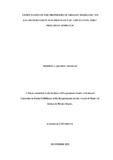COMPUTATION OF THE PROPERTIES OF ORGANIC-INORGANIC TIN HALIDE PEROVSKITE FOR PHOTOVOLTAIC APPLICATION; FIRST PRINCIPLES APPROACH
Abstract
The energy demand in today’s society is ever increasing because of the continuous
increase in population. Solar energy that uses solar cells which converts solar radiation
to electrical energy is of great importance. The first and second generation solar cells
in use are made of silicon that involves high cost of fabrication and lack of longevity
of the electric power generated. Therefore research has shifted to perovskite based solar
cells which have proven to be novel candidates for photovoltaic application because of
their availability and low cost of fabrication. However, they have not been
commercialized for photovoltaic applications because of their short life times which is
around one year. The purpose of this research was to study the electronic, structural,
the elastic and the dielectric properties of DASnI3 with an increased stability and the
materials’ potential photovoltaic application. Therefore in this work first principle
calculation and modeling based on Density Functional Theory (DFT) implemented in
Quantum espresso was used. The electronic, structural, elastic and the dielectric
constants of dimethylammonium triiodostanate(II) were determined using density functional theory within generalized gradient approximation (GGA) using plane-wave
basis set pseudopotentials method and using the Voigt–Reuss–Hill averaging scheme
for Elastic constant parameters. From this study lattice parameter a, b and c as 8.505 Å,
9.232 Å and 15.040 Å were obtained respectively for an orthorhombic DASNI3 with
60 atoms. The band gap of 2.7ev and the Poisson’s ratio (ν) of 0.36 were obtained from
this work. Dielectric constants which include the real (ε1) and imaginary part (ε2) and
the absorption coefficient were calculated the absorption begun from 2.5eV. The
anisotropy of 1.7 was also obtained. The values obtained for all the parameters were
compared with the available experimental and theoretical values. It was observed that
there was a fairly good agreement from the studies with this computational work. It was
concluded that this material is suitable for photovoltaic application. These findings can
be used to test experimentally the use of DASnI3 perovskite in solar cells.

